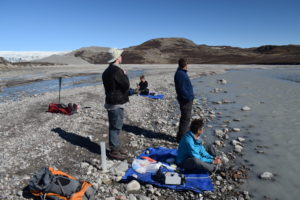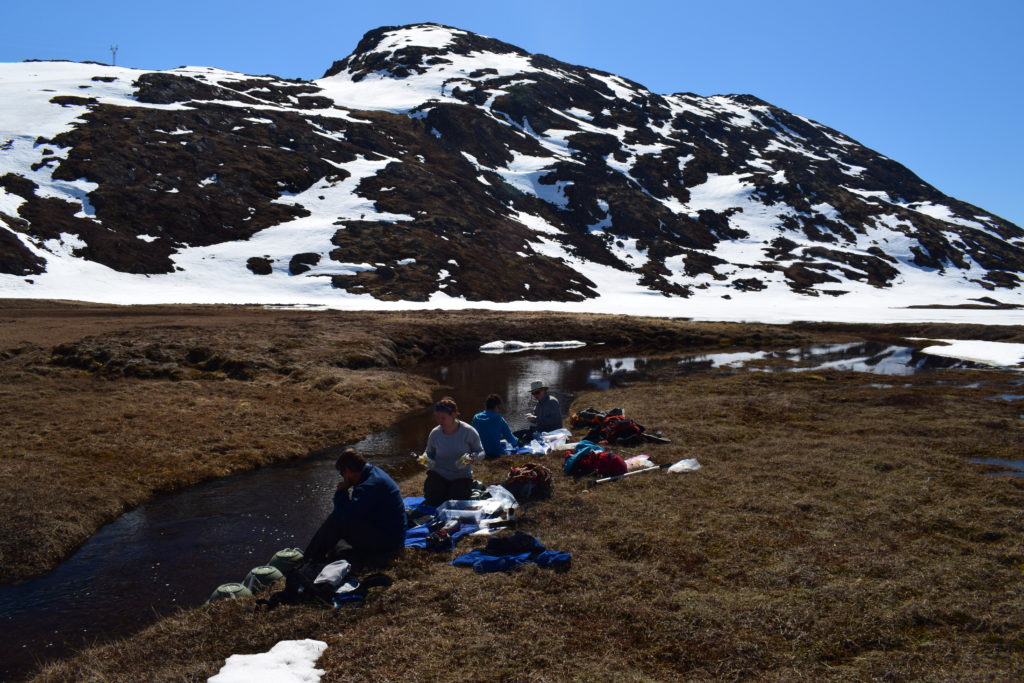We propose to test an overarching hypothesis that differences in the magnitudes and components of feedbacks between hydrologic, geochemical, and biological processes control variations in solute and gas fluxes across periglacial systems. We deconstruct this overarching hypothesis into three distinct sub-hypotheses linked to the different types of streams that drain the field area. Tests of these hypotheses will evaluate inputs, outputs, and transformations of organic and inorganic material among distinct periglacial watersheds.
The magnitude of phototrophic growth on and in the near-surface of ice sheets is modulated by solar forcing, temperature, delivery of nutrients in dust, and organic matter (OM) stored from previous melt seasons. Seasonal modulations of growth are punctuated by rapid changes in surface environments (temperature and dust delivery), altering the export of labile organic matter to subglacial drainage systems. Subglacial modification of supraglacial nutrients alters delivery of dissolved C, N, P, and Fe to the proglacial system, and greenhouse gases (CO2, CH4 and N2O) to the atmosphere. We predict:
- Ice surface production of OM and OM mineralization in subglacial distributed systems decreases DOC concentrations, but channelized drainage delivers more labile DOC at lower concentrations to subglacial outlets during peak melting.
- N/P ratios and Fe concentrations at glacial outlets are elevated during early melt season from sub-glacial weathering and both decrease as channelized subglacial flow develops, reflecting compositions in the supraglacial hydrologic system.
- Early melt season discharge from sub- to anoxic distributed subglacial systems elevates N2O and CH4 concentrations relative to CO2, but during peak melting, delivery of DO to channelized subglacial systems increases OM remineralization, the oxidation of CH4, and CO2 concentrations relative to other GHGs.
- Elevated 87Sr/86Sr and 143Nd/144Nd ratios at peak melting reflects lower weathering extent of newly comminuted supraglacial dust relative to lower 87Sr/86Sr and 143Nd/144Nd ratio from extensive subglacial weathering at low flow.
Significance: During glacial periods, high latitude oceanic and atmospheric fluxes are dominated by glacial processes but landscapes exposed during glacial terminations alter solute and gas fluxes. Thus, studies of modern ice edge processes increase capacity to assess past oceanic and atmospheric fluxes during glacial terminations and potential changes associated with polar warming and enhanced melting.
Solute, gas, and isotopic compositions of proglacial streams are altered during flow to the ocean through a combination of atmospheric evasion of gases, carbonation reactions, in-stream and hyporheic zone weathering, microbial metabolism, and water and solute delivery from deglaciated watershed tributaries. We predict:
- GHG-rich water delivered from distributed systems early in the melt season shifts to water with GHG concentrations close to atmospheric equilibrium as channelized drainages develop. GHGs equilibrate with atmospheric composition rapidly after discharge at glacial outlets and concentrations are altered through hyporheic exchange in sandurs, allowing weathering sequestration of CO2 and methanotrophic consumption of CH4.
- Elevated N/P ratios at subglacial outlets decrease prior to discharge to fjords as water with low N/P ratios drains from deglaciated watershed tributaries during freshet and from sandur hyporheic zones during freeze-in. During peak melting, N/P ratios at outlet portals are not modified prior to discharge to fjords.
Significance: Although much recent work demonstrates the importance of the fluxes at the ice edge, little is known about how gases and solutes are modified during transport from the ice edge to the ocean. Tests of these hypotheses will evaluate the magnitude and processes that lead to modifications in proglacial stream corridors. These modifications will become increasingly important with ice retreat as proglacial rivers flow greater distances to reach the coast.

Landscape characteristics of temperature, precipitation, light and water availability, slope, substrate composition, and OM and nutrient contents control biological community metabolism. These communities generate diurnal to seasonal shifts in concentrations of dissolved and gaseous forms of C and N, and dissolved P, Fe, and Si concentrations that modify solute and gas fluxes from terrestrial settings to streams, ocean, and atmosphere. We predict:
- Stream ecosystem metabolism shifts between net heterotrophy (NEP < 0) in early and late melt season and net autotrophy (i.e., net ecosystem production, NEP > 0) during mid-melt season in parallel with light availability. These metabolic shifts create seasonal variations in CO2 sinks and sources, linked to lability of DOC and its controls on soil OM mineralization and mineral weathering.
- Moss-dominated tundra in both arid and humid watersheds increase water-holding capacity of the landscape, thus limiting delivery of nutrients (N, P, Fe, Si) to streams relative to shrub dominated tundra. Infiltration during spring thaw and precipitation events will cause unidirectional drainage and solute delivery from the landscape to streams in humid watersheds but arid watersheds retain solutes because of concentration through evapotranspiration.
- Dissolution of P-bearing minerals in soil water increases availability of P relative to N in early melt season of humid watersheds, favoring symbiotic bryophyte-N fixing microbial communities. P is sequestered in Fe-oxides, raising N/P ratios, as flows decrease and DO concentrations increase with in-stream photosynthesis through the melt season.
- GHG concentrations are elevated during freshet in both humid and arid deglaciated watersheds, but CO2 concentrations dip below saturation in summer because of C fixation and mineral weathering, while CH4 and N2O remain supersaturated throughout the season.
- The offset between stream and bedload Nd isotopes will characterize weathering extent more precisely than offsets in Sr isotopes. During spring freshet preferential weathering of accumulated winter dust elevates87Sr/86Sr and 143Nd/144Nd ratios over baseflow values.
Significance: In a warming world, the growing season and precipitation will increase without changes in solar radiation. Thus, studies of feedbacks between hydrologic conditions, biogeochemical reactions, and productivity allow evaluations of how past fluxes during previous warmer interglacial periods, such as Marine Isotope Stages 5e and 11, differed from modern fluxes. This will improve our ability to reconstruct past ice sheet dynamics through an understanding of how Nd isotopes respond across a chemical weathering gradient, illuminating the relationship between fluxes and weathering in the past. These studies also improve capacity to predict future changes, which is critical for regional planning and emphasizes the need to communicate results with policy makers in local Greenlandic communities impacted by the warming Arctic.

